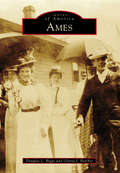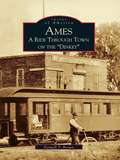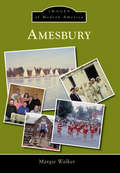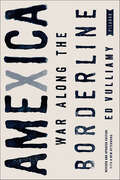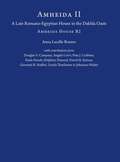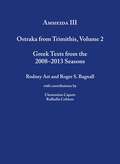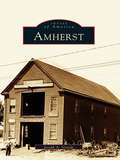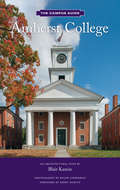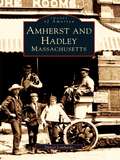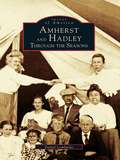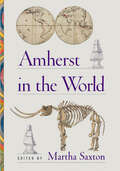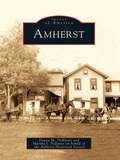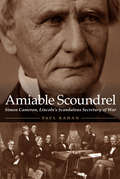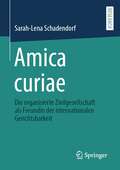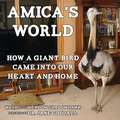- Table View
- List View
Ames (Images of America)
by Gloria J. Betcher Douglas L. BiggsAmes began as two communities. At its founding in 1864, Ames Station, on the Chicago & North Western Railway's main line, lay two miles east of Iowa Agricultural College, across the Squaw Creek. When the Ames & College Railway joined the college to the town in 1891, a cooperative spirit emerged that exists to this day. A rich history of achievements and colorful characters marks Ames's 150 years. One founding father commanded the 20th US Colored Infantry in the Civil War, while a Confederate veteran served as commander of the Iowa State College corps of cadets. Physicists at Iowa State College developed the uranium refinement process for the first atomic bomb and established the Ames Laboratory, the smallest US Department of Energy National Laboratory. Companies like Collegiate Manufacturing made material for the soldiers in World War II, and Kingland Systems now stands among global leaders in reference data software. Ames's businesses, citizens, and institutions, past and present, have created a rich community heritage for a vibrant, 21st-century city.
Ames: A Ride Through Town on the "Dinkey" (Images of America)
by Farwell T. BrownAmes has been referred to as a railroad town; more correctly the railroad established itself at the same moment that Iowa Agricultural College, now Iowa State University, was taking form. While the railroad helped to develop Ames, it was the college that drew people with names like Welch, Beardshear, "Tama Jim" Wilson, Charles F. Curtiss, and their successors. The flourishing academic community also drew families like the Loughrans and the Tildens, who were attracted by the positive town-gown relationship.In Ames: A Ride Through Town on the "Dinkey," readers will meet some of these people and tour historic Ames, as the narrow-gauge train nicknamed the "Dinkey" weaves its way through the city's history in over 220 vintage photographs. The images in this book, featuring people and landmarks both past and present, include Ames native J. Herman Banning, the first African-American aviator to be licensed in the U.S.; the dramatic 1922 burning and destruction of the Iowa State College Armory; a rare image of the 1895 Iowa State football team, the first to be called the Cyclones; and finally, downtown Ames' growth from dirt streets with wooden sidewalks to a modern college town.
Amesbury (Images of Modern America)
by Margie WalkerIn 1968, Amesbury celebrated its 300th anniversary. Residents compiled a cookbook, commemorative coins were sold, dances and plays were held, and townspeople dressed in period costume as part of the many events for the town's tercentenary. Since then, Amesbury has grown considerably, with many new businesses--furniture makers, fine food products, Norman's Restaurant, and clothing shops--emerging. Old mills have been reinvented into spaces for artists, photographers, and other creative outlets. The downtown area has been redeveloped and is a welcoming site as one enters Amesbury. One only needs to sit in Market Square, stroll along the Riverwalk, watch the falls of the Powow River in the Millyard, or listen to a concert in the amphitheater to experience Amesbury's charm. Despite a 1996 vote changing the town into a city, this great community retains the same small-town feel it has held for so many years.
Ametora: How Japan Saved American Style
by W. David MarxLook closely at any typically "American" article of clothing these days, and you may be surprised to see a Japanese label inside. From high-end denim to oxford button-downs, Japanese designers have taken the classic American look--known as ametora, or "American traditional"--and turned it into a huge business for companies like Uniqlo, Kamakura Shirts, Evisu, and Kapital. This phenomenon is part of a long dialogue between Japanese and American fashion; in fact, many of the basic items and traditions of the modern American wardrobe are alive and well today thanks to the stewardship of Japanese consumers and fashion cognoscenti, who ritualized and preserved these American styles during periods when they were out of vogue in their native land. In Ametora, cultural historian W. David Marx traces the Japanese assimilation of American fashion over the past hundred and fifty years, showing how Japanese trendsetters and entrepreneurs mimicked, adapted, imported, and ultimately perfected American style, dramatically reshaping not only Japan's culture but also our own in the process.
Amexica: War Along the Borderline
by Ed VulliamyAmexica is the harrowing story of the extraordinary terror unfolding along the U.S.-Mexico border—"a country in its own right, which belongs to both the United States and Mexico, yet neither"—as the narco-war escalates to a fever pitch there.In 2009, after reporting from the border for many years, Ed Vulliamy traveled the frontier from the Pacific coast to the Gulf of Mexico, from Tijuana to Matamoros, a journey through a kaleidoscopic landscape of corruption and all-out civil war, but also of beauty and joy and resilience. He describes in revelatory detail how the narco gangs work; the smuggling of people, weapons, and drugs back and forth across the border; middle-class flight from Mexico and an American celebrity culture that is feeding the violence; the interrelated economies of drugs and the maquiladora factories; the ruthless, systematic murder of young women in Ciudad Juarez. Heroes, villains, and victims—the brave and rogue police, priests, women, and journalists fighting the violence; the gangs and their freelance killers; the dead and the devastated—all come to life in this singular book.Amexica takes us far beyond today's headlines. It is a street-level portrait, by turns horrific and sublime, of a place and people in a time of war as much as of the war itself.
Amgen Inc.'s Epogen--Commercializing the First Biotech Blockbuster Drug
by Felix Oberholzer-Gee Dennis YaoAmgen Inc.'s Epogen was the first biotech blockbuster drug. Epogen helped prevent anemia, a condition that leads to severe fatigue, increased risk of cardiovascular disease, and even death. At the time, the market for Epogen, which included dialysis patients and persons with cancer undergoing chemotherapy, was estimated to be a $1 billion opportunity. After a critical scientific breakthrough, which allowed Amgen to identify the EPO gene, the company applied for a number of patents to protect its achievement. However, much to its surprise, Amgen learned that EPO had already been patented. Genetics Institute, the holder of the patent, demanded a royalty-free cross-license. Amgen's manager needed to decide how best to compete with its rival.
Amgen, Inc.: Planning the Unplannable
by Nitin Nohria James D. BerkleyBy the early 1990s, Amgen--a pharmaceutical company started little over a decade ago as Applied Molecular Genetics--was within range of becoming a billion-dollar company. With two extremely successful biotechnology drugs on the market, Amgen stood as the largest and most powerful independent company of its type in the world. Top executives in the company viewed long-range planning as an important ingredient in the firm's success; many others--including some of the firm's scientists--were less sure. With Amgen's sales expected to continue to grow rapidly, the firm's long-range planning process would be put to the test. Shows the different, sometimes paradoxical perspectives held within a single, dynamically changing company toward the issue of long-range planning. Students are challenged to synthesize these views into a coherent picture of a firm's growth amid great uncertainty.
Amheida I: Ostraka from Trimithis, Volume 1 (ISAW Monographs #7)
by Roger S. Bagnall Giovanni R. RuffiniThis volume presents 455 inscribed pottery fragments, or ostraka,found during NYU’s excavations at Amheida in the western desert of Egypt. Themajority date to the Late Roman period (3rd to 4th century AD), a time of rapidsocial change in Egypt and the ancient Mediterranean generally. Amheida was asmall administrative center, and the full publication of these brief textsilluminates the role of writing in the daily lives of its inhabitants. Thesubjects covered by the Amheida ostraka include the distribution of food, theadministration of wells, the commercial lives of inhabitants, their education,and other aspects of life neglected in literary sources. The authors provide afull introduction to the technical aspects of terminology and chronology, whilealso situating this important evidence in its historical, social and regionalcontext. Online edition available as part of the NYU Library's Ancient World Digital Library and in partnership with the Institute for the Study of the Ancient World (ISAW).
Amheida II: A Late Romano-Egyptian House in the Dakhla Oasis: Amheida House B2 (ISAW Monographs #4)
by Anna Lucille BoozerThis archaeological report provides a comprehensive study of the excavations carried out at Amheida House B2 in Egypt's Dakhleh Oasis between 2005 and 2007, followed by three study seasons between 2008 and 2010.The excavations at Amheida in Egypt's western desert, begun in 2001 under the aegis of Columbia University and sponsored by NYU since 2008, are investigating all aspects of social life and material culture at the administrative center of ancient Trimithis. The excavations so far have focused on three areas of this very large site: a centrally located upper-class fourth-century AD house with wall paintings, an adjoining school, and underlying remains of a Roman bath complex; a more modest house of the third century; and the temple hill, with remains of the Temple of Thoth built in the first century AD and of earlier structures. Architectural conservation has protected and partly restored two standing funerary monuments, a mud-brick pyramid and a tower tomb, both of the Roman period.This volume presents and discusses the architecture, artifacts and ecofacts recovered from B2 in a holistic manner, which has rarely before been attempted in a full report on the excavation of a Romano-Egyptian house. The primary aim of this volume is to combine an architectural and material-based study with an explicitly contextual and theoretical analysis. In so doing, it develops a methodology and presents a case study of how the rich material remains of Romano-Egyptian houses may be used to investigate the relationship between domestic remains and social identity.
Amheida III: Ostraka from Trimithis, Volume 2 (ISAW Monographs #5)
by Roger S. Bagnall Rodney AstThis archaeological report provides a comprehensive study of the excavations carried out at Amheida House B2 in Egypt's Dakhleh Oasis between 2005 and 2007, followed by three study seasons between 2008 and 2010. The excavations at Amheida in Egypt's western desert, begun in 2001 under the aegis of Columbia University and sponsored by NYU since 2008, are investigating all aspects of social life and material culture at the administrative center of ancient Trimithis. The excavations so far have focused on three areas of this very large site: a centrally located upper-class fourth-century AD house with wall paintings, an adjoining school, and underlying remains of a Roman bath complex; a more modest house of the third century; and the temple hill, with remains of the Temple of Thoth built in the first century AD and of earlier structures. Architectural conservation has protected and partly restored two standing funerary monuments, a mud-brick pyramid and a tower tomb, both of the Roman period. This is the second volume of ostraka from the excavations Amheida (ancient Trimithis) in Egypt. It adds 491 items to the growing corpus of primary texts from the site. In addition to the catalog, the introductory sections make important contributions to understanding the role of textual practice in the life of a pre-modern small town. Issues addressed include tenancy, the administration of water, governance, the identification of individuals in the archaeological record, the management of estates, personal handwriting, and the uses of personal names. Additionally, the chapter "Ceramic Fabrics and Shapes” by Clementina Caputo breaks new ground in the treatment of these inscribed shards as both written text and physical object. This volume will be of interest to specialists in Roman-period Egypt as well as to scholars of literacy and writing in the ancient world and elsewhere.
Amherst
by Joseph A. GrandeAmherst depicts the breathtaking evolution of a small farming community into a major economic, educational, and medical hub of western New York. The book reveals how Amherst's rich soils, rapid falls, and near-Buffalo location led to the community's great progress and growth. In a single century, the population rose from just over four thousand in 1900 to one hundred fifteen thousand in 2000. Today, the town includes the thousand-acre campus of the new State University of New York at Buffalo and the Amherst Museum, visited by more than fifty thousand people each year.
Amherst College: The Campus Guide (The Campus Guide)
by Blair KaminAmherst College: The Campus Guide is an architectural tour of one of North America's most prestigious liberal arts colleges. Founded in Western Massachusetts some two hundred years ago, the one thousand-acre campus is a living museum of architectural history, bearing the imprint of distinguished firms in architecture and landscape architecture: Frederick Law Olmsted; McKim, Mead & White; Benjamin Thompson; Edward Larrabee Barnes; Shepley Bulfinch; and Michael Van Valkenburgh. Organized as a series of six walks, the guide interweaves the history of the college with the story of the campus's development. Newly commissioned photographs and a hand drawn pocket map enhance this engaging journey through Amherst's architecture, landscape, interior design, and sculpture.
Amherst and Hadley, Massachusetts (Images of America)
by Daniel LombardoOnce part of Hadley, the town of Amherst is known the world over as the home of celebrated poet Emily Dickinson. This photographic portrait of Emily'ssurroundings reveals the beautiful landscape that inspired her art, and also includes less typical but nonetheless significant images of hard-working farmhands, Irish laborers, Italian peanut vendors, riotous college students, and feuding factory workers. These two towns at the heart of the Connecticut River Valley have been appreciated by poets and artists for many years, and their bucolic and pastoral character is celebrated in this marvelous new examination of the towns' historyin photographs from 1860 through the early twentiethcentury. Famous residents of and visitors to the area are featured, including Dickinson, Robert Frost, Henry Ward Beecher and Noah Webster. Mr. Lombardo's book combines a serious look at these historical figures with a humorous perspective on some of the area's more colorful characters, such as Charles King, the Amherst barber who became famous for eating fifty eggs in fifteen minutes.
Amherst and Hadley: Through the Seasons (Images of America)
by Daniel LombardoNestled deep in the Connecticut River Valley areAmherst and Hadley, two New England towns responsible for the inspiration of many classic poets, writers, and thinkers of America. In Amherst and Hadley: Through the Seasons, the landscape changes continuously throughout the seasons. Each season brings its own natural beauty and dangers, from the scorching summers to the bitter winters.This photographic history offers a rare glimpse of Robert Frost's world of fire and ice. Visit a place where Ralph Waldo Emerson ate dinners with Emily Dickinson's family and see the site on which Noah Webster founded Amherst College. Look through a visual record of small towns, where the seasonal changes of the hills, fields, and woods inspired local writer Ray Stannard Baker and area photographer Clifton Johnson. Meander through a place that left fond memories in the hearts and minds of former Supreme Court Chief Justice Harlan Fiske Stone and writer Sylvia Plath.
Amherst in the World
by Martha SaxtonIn celebration of the 200th anniversary of Amherst College, a group of scholars and alumni explore the school’s substantial past in this volume. Amherst in the World tells the story of how an institution that was founded to train Protestant ministers began educating new generations of industrialists, bankers, and political leaders with the decline in missionary ambitions after the Civil War. The contributors trace how what was a largely white school throughout the interwar years begins diversifying its student demographics after World War II and the War in Vietnam. The histories told here illuminate how Amherst has contended with slavery, wars, religion, coeducation, science, curriculum, town and gown relations, governance, and funding during its two centuries of existence. Through Amherst’s engagement with educational improvement in light of these historical undulations, it continually affirms both the vitality and the utility of a liberal arts education. Contributions by Martha Saxton, Gary J. Kornblith, David W. Wills, Frederick E. Hoxie, Trent Maxey, Nicholas L. Syrett, Wendy H. Bergoffen, Rick López, Matthew Alexander Randolph, Daniel Levinson Wilk, K. Ian Shin, David S. Reynolds, Jane F. Thrailkill, Julie Dobrow, Richard F. Teichgraeber III, Debby Applegate, Michael E. Jirik, Bruce Laurie, Molly Michelmore, and Christian G. Appy.
Amherst: 1881-1982 (Images of America)
by Amherst Historical Society Donna M. Deblasio Martha I. PallanteEstablished in 1811, Amherst has been actively engaged in the quarrying of high-quality sandstone since before the American Civil War. The products of the town's quarries have graced buildings and other structures in the United States and around the world. The promise of work at the quarries drew potential employees from the surrounding countryside, as well as from across the ocean, giving the community's population its diverse character. This photographic history presents the unique and fascinating story of Amherst, the self-described "Sandstone Center of the World."
Ami Ami Dogs 2
by Mitsuki HoshiThis Amigurumi handbook is filled with new breeds of adorable miniature puppies. Photos inside reveal the secret, devilish world of your little friends, along with easy-to-follow patterns to help you create them. These sweet creatures are perfect additions to any Amigurumi collection. The world needs more Ami Ami Dogs
Ami Ami Dogs: Seriously Cute Crochet
by Mitsuki HoshiThis Amigurumi handbook is filled with adorable photographsof puppies and easy-to-follow patterns to help youcreate them. Treat yourself to a darling friend to cuddle up with,make an entire family of puppies, or gift one to a loved one.The world needs moreAmi Ami Dogs
Ami Ami Kittens: Seriously Cute Crochet!
by Mitsuki HoshiThe third colorful and imaginative installment in the illustrated amigurumi series, following Ami Ami Dogs and Ami Ami Dogs 2. Amigurumi, which translates to knitted stuffed toy in Japanese, is the art of crocheting cute stuffed animals with large heads and small bodies. Ami Ami Kittens is packed with projects for all crochet lovers offering them directions and inspiration for creating a range of fun and irresistible yarn kittens. Detailed, easy-to-follow instructions, illustrations, and enchanting color photographs teach them how to create these super adorable felines of various breeds and types, including Tabby, Pointed, Black/White Solid, Black and White, Calico, Scottish Fold, Siamese, Russian Blue, Munchkin, Maine Coon, British Shorthair, and American Shorthair. Here, too, are instructions for transforming them into key chains, finger puppets, and magnets. Ami Ami Kittens covers a wide range of techniques, from basic crochet skills perfect for beginners to more challenging patterns for experts, and offers spiral methods to ensure that the stuffing stays inside the finished piece. Filled with pretty, fun, and irresistibly adorable young cats, Ami Ami Kittens provides hours of fun for every knitter-and cat lovers, too.
Amiable Scoundrel: Simon Cameron, Lincoln's Scandalous Secretary of War
by Paul KahanFrom abject poverty to undisputed political boss of Pennsylvania, Lincoln’s secretary of war, senator, chair of the Senate Foreign Relations Committee, and a founder of the Republican Party, Simon Cameron (1799–1889) was one of the nineteenth century’s most prominent political figures. In his wake, however, he left a series of questionable political and business dealings and, at the age of eighty, even a sex scandal. Far more than a biography of Cameron, Amiable Scoundrel is also a portrait of an era that allowed—indeed, encouraged—a man such as Cameron to seize political control. The political changes of the early nineteenth century enabled him not only to improve his status but also to exert real political authority. The changes caused by the Civil War, in turn, allowed Cameron to consolidate his political authority into a successful, well-oiled political machine. A key figure in designing and implementing the Union’s military strategy during the Civil War’s crucial first year, Cameron played an essential role in pushing Abraham Lincoln to permit the enlistment of African Americans into the U.S. Army, a stance that eventually led to his forced resignation. Yet his legacy has languished, nearly forgotten save for the fact that his name has become shorthand for corruption, even though no evidence has ever been presented to prove that Cameron was corrupt.Amiable Scoundrel puts Cameron’s actions into a larger historical context by demonstrating that many politicians of the time, including Abraham Lincoln, used similar tactics to win elections and advance their careers. This study is the fascinating story of Cameron’s life and an illuminating portrait of his times.
Amica curiae: Die organisierte Zivilgesellschaft als Freundin der internationalen Gerichtsbarkeit
by Sarah-Lena SchadendorfDas prozessrechtliche Institut des amicus curiae („Freund des Gerichts“) hat insbesondere seit den 1990er Jahren eine Internationalisierung erfahren und Eingang in das Völkerverfahrensrecht gefunden. Dieses Buch legt eine umfassende empirische Bestandsaufnahme der amicus curiae-Praxis einer repräsentativen Auswahl internationaler Gerichte vor und greift die organisierte Zivilgesellschaft als prägende Akteurin heraus. Unter Berücksichtigung gerichtsspezifischer Besonderheiten umfasst die Bestandsaufnahme die Rechtsgrundlagen und Beweggründe sowie die bisherige Zulassungs- und Berücksichtigungspraxis und soll den theoretisch-konzeptionellen Debatten eine praktische Perspektive gegenüberstellen. Die anschließende gerichtsvergleichende Betrachtung veranschaulicht den vor internationalen Gerichten etablierten Verfahrensstandard, den Einfluss der Stellungnahmen zivilgesellschaftlicher Organisationen auf die Rechtsprechung der internationalen Gerichte sowie die Arten, Funktionen und Potentiale zivilgesellschaftlicher amici curiae in internationalen Gerichtsverfahren.
Amica's World: How a Giant Bird Came into Our Heart and Home
by Jane Goodall Meadow Shadowhawk Washo ShadowhawkAmica is a rhea-a flightless bird in the ratite family, related to ostriches, emus, and kiwis. Amica was adopted as a young chick and in turn quickly adopted mother and son Meadow and Washo Shadowhawk as his flock and made himself at home in their living room.Now an adult, Amica stands nearly six feet tall, and has a six-foot wingspan. By day he roams the backyard, exploring, running, and building nests, along with his friends the chickens and the dog. At night, he watches television and sleeps in the living room with his friend the cat.What's it like living with a rhea? As you'll discover in the words and photos in this book, it is never boring, and requires massive sacrifices. Rheas, which are typically hunted or raised as livestock, are highly intelligent and expressive, with a humanlike range of emotions. Amica's extraordinary story shows the powerful and surprising connections that can be forged between humans and animals.
